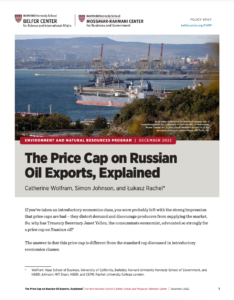Full Title: The Price Cap on Russian Oil Exports, Explained
Author(s): Catherine Wolfram, Simon Johnson, and Łukasz Rachel
Publisher(s): Harvard Kennedy School, Belford Center for Science and International Affairs
Publication Date: December 5, 2022
Full Text: Download Resource
Description (excerpt):
If you’ve taken an introductory economics class, you were probably left with the strong impression that price caps are bad – they distort demand and discourage producers from supplying the market. So, why has Treasury Secretary Janet Yellen, the consummate economist, advocated so strongly for a price cap on Russian oil? The answer is that this price cap is different from the standard cap discussed in introductory economics classes.
A standard price cap applies to all goods traded in a market. For example, in some countries there are price caps on bread for everyone or diesel for farmers or rent controls on housing. Such caps lead to excess demand for the good and insufficient supply, leading to shortages at the capped price. If prices are constrained, other non-price mechanisms, like first-come-first-served, are required to allocate the good. All too frequently, the result is empty bakery shelves or fuel shortages or difficulties finding housing. To understand why the cap on Russian oil is different, we first need to provide background on Russian oil trade and the proposed price cap.
